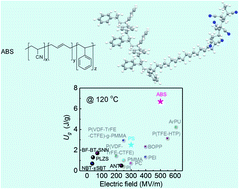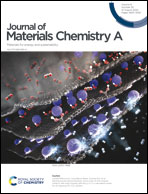A high-temperature dielectric polymer poly(acrylonitrile butadiene styrene) with enhanced energy density and efficiency due to a cyano group†
Abstract
High-temperature film capacitors have been widely used in numerous applications, such as energy storage components in hybrid electric vehicles, smart grids and pulsed power sources. The commercial film capacitors fabricated by biaxially oriented polypropylene (BOPP) possess high energy efficiency, but low energy density of 2.0–3.0 J cm−3, which restricts their applications. In this work, a poly(acrylonitrile butadiene styrene) (ABS) polymer was prepared by a solution cast method. A high room temperature discharged energy density was achieved, being on the order of 7.3 J cm−3 at 525 MV m−1, benefitting from the aromatic groups and high polar cyano group in the ABS polymer. Of particular significance is that high energy density (6.7 J cm−3) and efficiency (75%) were simultaneously achieved at an elevated temperature of 120 °C under 500 MV m−1. It is worth noting that the gravimetric energy density, being on the order of 6.3 J g−1 at 120 °C, is significantly higher than the values of other high-temperature energy storage dielectrics. Together with its excellent thermal stability and cycling reliability (105 cycles), the ABS polymer demonstrates that it is a promising candidate for high power energy storage capacitors at elevated temperatures.



 Please wait while we load your content...
Please wait while we load your content...